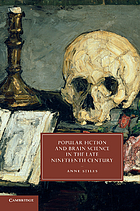
Nonspecialists and those who are just starting to explore the intersection of the arts and cognitive science have at their disposal a number of accessible overviews. For example, Art, Aesthetics, and the Brain, edited by Joseph Huston and other professionals in the areas of psychology and physiology, interrogates visual art, music, and dance. This collection provides an entry point to topics such as neuroculture, cognitive aesthetics, art and dementia, hemispheric specialization, eye-tracking research, the cognitive study of faces, and theories of how natural selection led to the evolution of arts. Neuroscientist Eric Kandel’s The Age of Insight: The Quest to Understand the Unconscious in Art, Mind, and Brain: From Vienna 1900 to the Present offers a wonderful, intertwined exploration of how psychology, vision, and art relate to each other. Kandel focuses primarily on the visual arts of the early twentieth century by artists like Gustav Klimt and Egon Schiele. Kandel followed up this study with another book that addresses abstraction—Reductionism in Art and Brain Science: Bridging the Two Cultures—which uses visual perception and memory as frameworks for understanding both top-down and bottom-up processing of paintings.1 In the area of scientific studies of creativity, computer scientist and pianist R. Keith Sawyer’s Explaining Creativity: The Science of Human Innovation is a good overview for beginners. Another excellent entry point is cognitive scientist Robert Solso’s The Psychology of Art and the Evolution of the Conscious Brain. Solso explores how humans appreciate aesthetic properties of art, depend on perceptual abilities when experiencing art, and use cognitive schemata when looking at art. This book includes a fascinating summary of research involving neuroimaging of the brain and aesthetic processing, an area that has continued to see great technological advancement. This book builds on Solso’s earlier, insightful overview, Cognition and the Visual Arts. Elaine Strosberg’s Art and Science is also worthy, and the chapter “Painting and Cognition” is a pleasure to browse. Although now dated, cognitive scientist Donald Hoffman’s Visual Intelligence: How We Create What We See was a landmark study when published in 1998. It focuses on visual perception, including the brain and optical illusions in art.
More specialized treatments can also be friendly starting points for those just entering the field of cognitive science and the visual arts. Grounded in scientific history, Amy Ione’s Art and the Brain: Plasticity, Embodiment, and the Unclosed Circle traces the evolution of the brain, the visual representation of the brain, the evolution of neuroscience, the ways that images of the brain can be matched with scientific theories, and how other primates perceive the world in similar ways. She includes historical drawings and paintings of brains and a history of brain-related research that spans millennia. Neurobiologist Margaret Livingstone illustrates the commonalities between art and visual perception in Vision and Art: The Biology of Seeing. Spanning art works from the Renaissance to the modern era, Livingstone’s book explains how artists exploit functions of the human eye and brain to produce a wide range of visual effects with pictorial elements of perspective, luminance, color mixing, shading, and chiaroscuro. In Interpreting Visual Art: A Survey of Cognitive Research about Pictures, psychologists Catherine Weir and Evans Mandes provide an overview of how conceptual mechanisms related to attention, memory, and language inform aesthetic experience. Their discussion of research on eye tracking and scrambled images of faces merits special mention. Psychologist George Mather’s The Psychology of Visual Art: Eye, Brain and Art provides an excellent integration of visual science, evolutionary psychology, and the psychology of art. Mather discusses research on art made by people with dementia and brain lesions, the perception of motion and color, and eye tracking focused on faces. Also excellent is psychologist Arthur Shimamura’s Experiencing Art: In the Brain of the Beholder, which does an excellent job of introducing how taste and aesthetics are processed in the cerebral cortex, how body language informs art appreciation, and how art may activate a dopamine reward circuit. Shimamura includes a discussion of research using neuroimaging, including MRIs.
The field of literary studies has also benefitted greatly from cognitive scientific work. In Popular Fiction and Brain Science in the Late Nineteenth Century, Anne Stiles intertwines the history of science with the history of literature, explaining that such celebrated authors as Robert Louis Stevenson, Bram Stoker, and H. G. Wells were fascinated by neurological experiments, which inspired their creative work. In The Neural Imagination: Aesthetic and Neuroscientific Approaches to the Arts, literary scholar Irving Massey devotes half of the text to using neuroscience to locate aesthetic experience of literature, music, and visual art within the brain. He devotes the other half of the text to a contrasting humanist approach, meant to show that traditional work in the humanities can provide insights about cultural values that scientific work cannot. In doing so, he clarifies both the strengths of using brain science to study aesthetics—for example, the ability to localize the experience of beauty within the brain—and the limitations of a scientific approach—e.g., the inability to understand history using brain scans.
Those approaching this subject from a theoretical background may find writer-philosopher Alva Noë’s Strange Tools: Art and Human Nature a good entry point. Noë offers a philosophical treatment of the ways that art is both a product and facilitator of humans’ biological need for organization. Noë develops his thesis on art and human nature by drawing on such well-known theorists as René Descartes, John Dewey, Martin Heidegger, William James, Immanuel Kant, Plato, and Ludwig Wittgenstein.
1. Top-down visual processing relies on information already stored in the brain—what one has learned about and remembers from the past—to generate meaning. Bottom-up visual processing relies on sensory input—the colors, shapes, lines, textures, and other visual information detected by light focused on the retina. As they navigate the world, people usually use top-down and bottom-up visual processing concurrently.
 Popular Fiction and Brain Science in the Late Nineteenth Century by
Popular Fiction and Brain Science in the Late Nineteenth Century by